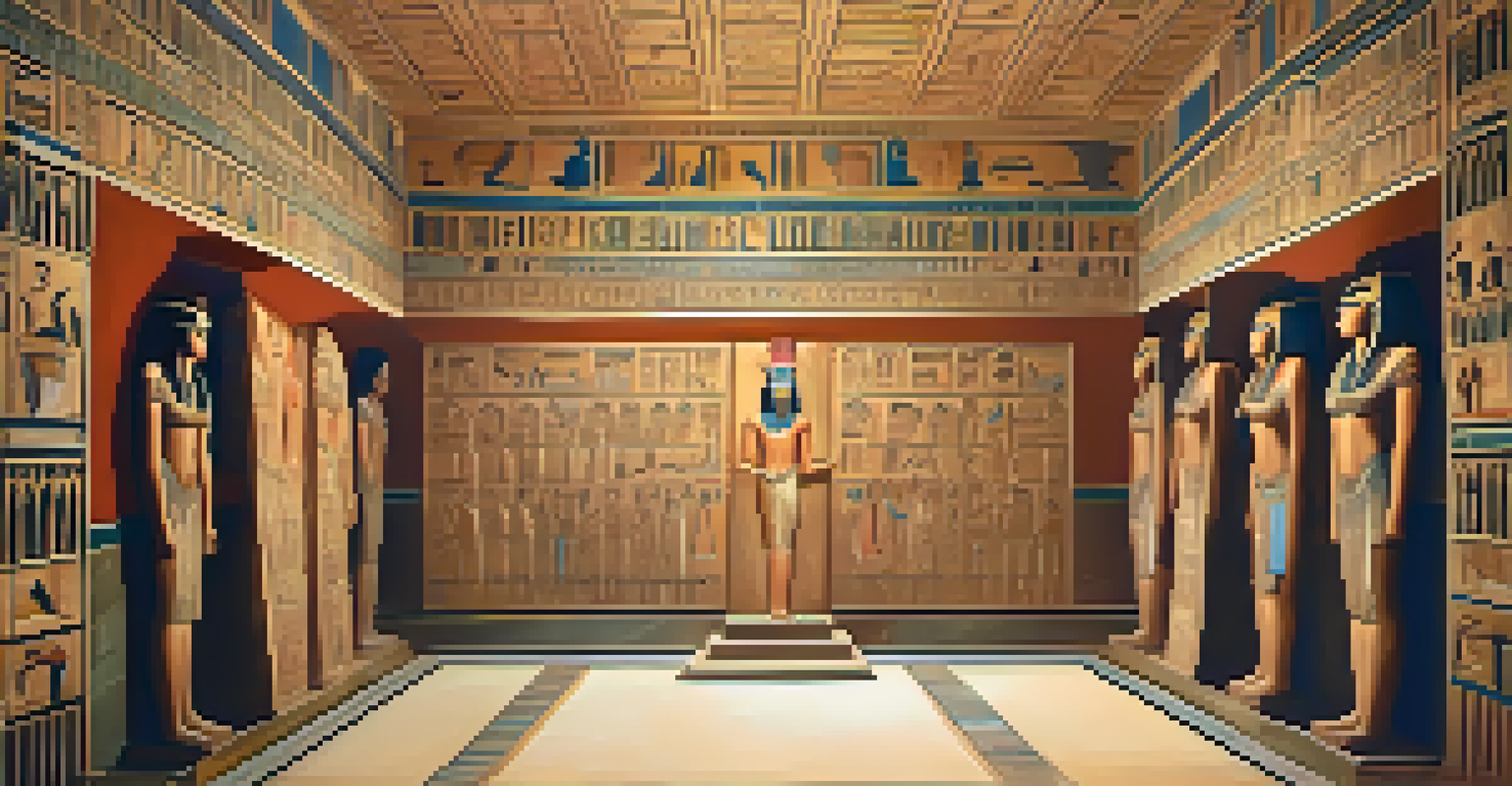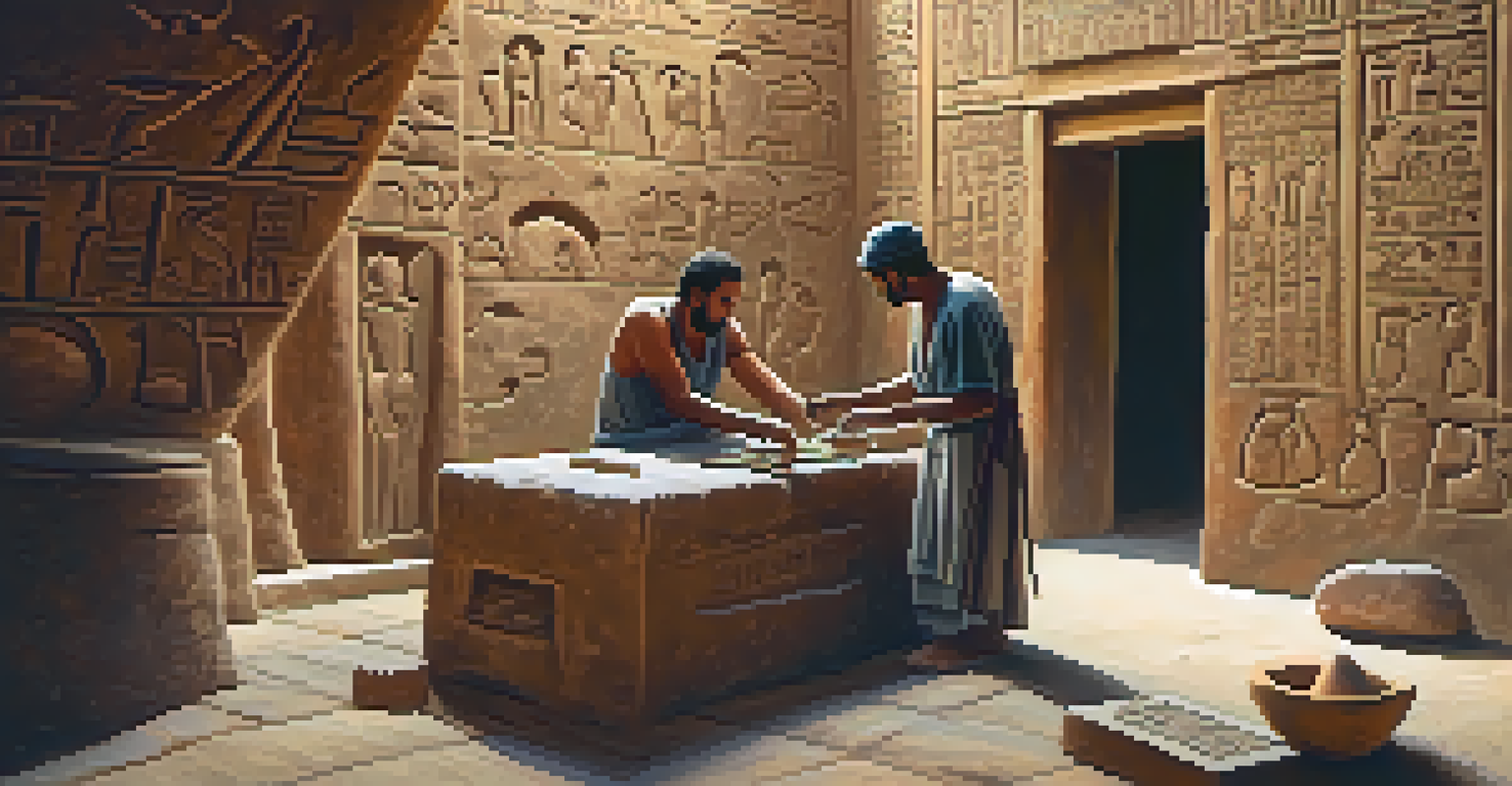The Role of Carving in Ancient Egyptian Culture and Beliefs

Carving: An Integral Art Form in Ancient Egypt
Carving was more than just a decorative art form in ancient Egypt; it played a crucial role in their daily lives and spiritual beliefs. From hieroglyphs to intricate reliefs, the Egyptians used carving to communicate stories, preserve history, and convey their religious beliefs. The precision and skill involved in this craft reflect the civilization's deep appreciation for art and its significance in their culture.
Art is the most beautiful of all lies.
Many tools were used for carving, such as chisels made from stone and metal, which allowed artisans to create detailed and lasting works. The process of carving required years of training, and those who mastered it held esteemed positions in society. This reverence for craftsmanship is evident in the well-preserved temples and tombs that still stand today.
Carving was not only an artistic endeavor but also served practical purposes, such as decorating monuments and enriching burial sites. This artistic legacy continues to fascinate people today, illustrating the importance of carving in shaping ancient Egyptian identity.
Spiritual Significance of Carvings in Ancient Egypt
In ancient Egypt, carvings often depicted gods, goddesses, and mythological stories, intertwining art with spirituality. These carvings were believed to hold divine power, serving as a connection between the physical world and the afterlife. For instance, tomb engravings were meant to guide the deceased through the afterlife, ensuring a safe passage to the realm of Osiris, the god of the underworld.

The meticulous details in carvings were not just for aesthetics; they were infused with meaning and symbolism. Each figure and scene told a story, representing various aspects of life, death, and rebirth. This emphasis on symbolism reflects the Egyptians' profound beliefs about the afterlife and the importance of honoring their deities through art.
Carving's Role in Ancient Life
Carving was essential in ancient Egypt, serving both artistic and practical purposes that reflected their culture and spirituality.
Moreover, the placement of these carvings was intentional, often found in sacred spaces like temples and tombs. This strategic positioning highlighted their significance and allowed worshippers to engage with the divine through visual storytelling.
Hieroglyphics: The Language of Carving
Hieroglyphics, the writing system of ancient Egypt, is a prime example of how carving infused language with art. Each symbol was intricately carved, representing not only sounds but also concepts and ideas. This unique blend of art and communication was vital for record-keeping, religious texts, and monumental inscriptions.
The past is never dead. It's not even past.
The use of hieroglyphics was not limited to simple messages; it often included elaborate carvings that told the stories of pharaohs and their accomplishments. For instance, the famous Rosetta Stone features inscriptions that helped modern scholars decode this ancient language, revealing the depth of Egyptian civilization.
Through hieroglyphics, the Egyptians were able to preserve their history for future generations. These carvings served as a bridge between the past and present, allowing us to glimpse into the beliefs and values of a civilization long gone.
Carving Techniques and Tools of the Ancient Egyptians
The ancient Egyptians employed a variety of carving techniques that showcased their skill and creativity. They utilized tools made from materials like copper, stone, and wood, each designed for specific tasks. For instance, harder stones were carved using chisels, while softer materials allowed for more intricate designs.
One of the most common techniques was relief carving, where figures were carved into a flat surface, creating a three-dimensional effect. This method added depth to the artwork and allowed for dynamic storytelling within the carvings. The shadows cast by the reliefs further enhanced the visual impact of the artwork.
Spiritual Significance of Carvings
Carvings held deep spiritual meaning, depicting gods and guiding the deceased through the afterlife with intricate details and symbolism.
Additionally, the artistry involved in carving was often a collaborative effort, with teams of artisans working together to create large-scale projects like temples and monuments. This teamwork not only showcased their skills but also fostered a sense of community and shared purpose among the craftsmen.
The Role of Carving in Egyptian Funerary Practices
Carving played a pivotal role in the funerary practices of ancient Egyptians, serving to honor the deceased and prepare them for the afterlife. Tombs were often adorned with detailed carvings that depicted scenes from the deceased's life, intended to accompany them in their journey beyond death. These artistic representations aimed to ensure that the individual would be remembered and protected in the afterlife.
The inclusion of spells and prayers carved into the walls of tombs further highlights the spiritual significance of these artworks. Known as the Pyramid Texts, these inscriptions were meant to assist the deceased in navigating the challenges of the afterlife, providing guidance and protection.
By incorporating both art and spirituality into their funerary practices, the ancient Egyptians created a rich tapestry of beliefs surrounding death and the afterlife. The intricate carvings serve as a lasting testament to their dedication to honoring those who had passed.
Influence of Carving on Modern Perceptions of Ancient Egypt
The remarkable carvings of ancient Egypt continue to captivate and inspire people around the world today. They provide valuable insight into the culture, beliefs, and daily life of a society that thrived thousands of years ago. Modern archaeologists and historians study these carvings to understand better the complexities of ancient Egyptian civilization.
Moreover, the aesthetic qualities of Egyptian carvings have influenced contemporary art and architecture. Artists often draw inspiration from the stylized figures and symbolic representations found in ancient Egyptian art, creating a lasting legacy that bridges time and culture.
Preservation of Ancient Heritage
Efforts to preserve ancient Egyptian carvings are vital for understanding and appreciating the artistic legacy and cultural heritage of this civilization.
The fascination with Egyptian carvings has also permeated popular culture, with references appearing in movies, literature, and art exhibits. This enduring interest reflects the universal human desire to connect with the past and understand the beliefs that shaped ancient societies.
Preservation Efforts for Ancient Carvings
Preserving the intricate carvings of ancient Egypt is crucial for maintaining our understanding of this vibrant culture. As time progresses, many of these carvings face threats from environmental factors, tourism, and human neglect. Preservation efforts, including controlled climate conditions and careful restoration techniques, are essential to protect these historical treasures.
Organizations and governments are increasingly recognizing the importance of safeguarding Egypt's cultural heritage. Initiatives aimed at documenting and preserving carvings not only help maintain their physical integrity but also enhance public awareness about their significance.

These preservation efforts ensure that future generations can appreciate and learn from the rich artistic legacy of ancient Egypt. By valuing and protecting these carvings, we honor the creativity and beliefs of a civilization that continues to inspire and educate us today.